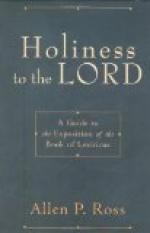As we bend our heads, the occipital condyles revolve or glide on the sockets of the atlas. But what will happen if we roll our heads backwards to such an extent that the bony edge of the opening in the base of the skull is made to press hard against the brain stem and crush it? That, of course, would mean instant death. Such an accident has been made impossible (1) by making the opening in the base of the skull so much larger than the brain stem that in extreme movements there can be no scissors-like action; (2) the muscles which move the head on the atlas arrest all movements long before the danger-point is reached; (3) even if the muscles are caught off their guard, as they sometimes are, certain strong ligaments—fastenings of tough fibres—are so set as automatically to jam the joint before the edge of the foramen can come in contact with the brain stem.
These are only some of the devices which Nature had to contrive in order to secure a safe passageway for the brain stem. But in obtaining safety for the brain stem, the movements of the head on the atlas had to be limited to mere nodding or side-to-side bending. The movements which are so necessary to us, that of turning our heads so that we can sweep our eyes along the whole stretch of the skyline from right to left, and from left to right, were rendered impossible. This defect was also overcome in a simple manner. The joints between the first and second vertebrae—the atlas and axis—were so modified that a turning movement could take place between them instead of between the atlas and skull. When we turn or rotate our heads, the atlas, carrying the skull upon it, swings or turns on the axis. When we search for the manner in which this has been accomplished, we see again that Nature has made use of the simplest means at her disposal. When we examine a vertebra in the course of construction within an unborn animal, we see that it is really made up by the union of four parts (see Fig. 4): a central block which becomes the “body” or supporting part; a right and a left arch which enclose a passage for the spinal cord; and, lastly, a fourth part in front of the central block which becomes big and strong only in the first vertebra—the atlas. When we look at the atlas (Fig. 4), we see that it is merely a ring made up of three of the parts—the right and left arches and the fourth element,—but the body is missing. A glance at Fig. 4, B, will show what has become of the body of the atlas. It has been joined to the central block of the second vertebra—the axis—and projects upwards within the front part of the ring of the atlas, and thus forms a pivot round which rotatory movements of the head can take place. Here we have in the atlas an approach to the formation of a wheel—a wheel which has its axle or pivot placed at some distance from its centre, and therefore a complete revolution of the atlas is impossible. A battery of small muscles is attached to the lateral levers of the atlas and can swing it freely, and the head which it carries, a certain number of degrees to both right and left. The extent of the movements is limited by stout check ligaments. Thus, by the simple expedient of allowing the body of the atlas to be stolen by the axis, a pivot was obtained round which the head could be turned on a horizontal plane.




